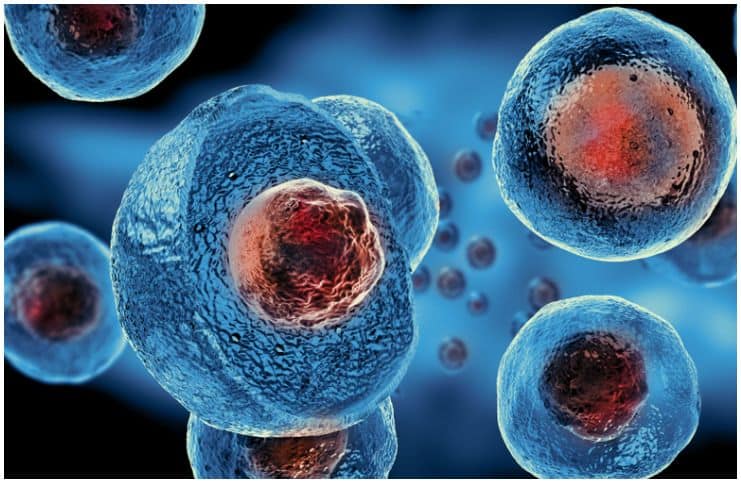Here Is A List Of The Top 33 Interesting Facts About Nucleus:
#1 The nucleus (plural, nuclei) is a spherical-shaped organelle that is present in every eukaryotic cell. It occupies approximately 10 percent of the total volume of the cell.
#2 The smallest nuclei are about 1 μm in diameter and are found in yeast cells. But, the nucleus is normally 5 to 10 μm in diameter in most multicellular organisms, and the largest organelle in the cell.
#3 This organelle has two primary functions – it coordinates the cell’s activities, which include intermediary metabolism, growth, reproduction (cell division), and protein synthesis, and it stores the cell’s hereditary material (DNA).
#4 Eukaryotes commonly have a single nucleus, however, a few cell types are multinucleate (consists of 2 or more nuclei), for instance, slime molds, whereas some cells are enucleate cells (without a nucleus), for instance, red blood cells.
#5 There’s no fixed shape to the nucleus, nevertheless, in most cases, nuclei are round or elliptical, disc-shaped, or oval-shaped.
#6 The word ”nucleus” is derived from the Latin word ”nuculeus” that means ”kernel.”
#7 The development of the nucleus contributed to the evolution of complex life forms by separating transcription from translation and by providing a structural framework for regulating or organizing larger genomes.
#8 The nucleus is not always in the center of the cell. In some cases, it will be a big dark spot somewhere in the middle of all of the cytoplasm.
Functions
#9 The main function of the nucleus is to store a cell’s hereditary material (DNA) that helps with and controls a cell’s function, growth, and reproduction. The DNA molecules are organized in a linear fashion inside the nucleus.
#10 The DNA is also used to control gene expression through a process called transcription, where a DNA template is used to produce pre-mRNA.
#11 The nucleus performs many functions, including:
- it produces ribosomes that are known as protein factories;
- it controls the heredity characteristics of an organism;
- it regulates the integrity of genes and gene expression;
- it is responsible for cell division, protein synthesis, and differentiation;
- it stores proteins and ribonucleic acid in the nucleolus.
Structure
A cell nucleus contains the following parts:
Nuclear Membrane
#12 The nuclear membrane, also known as the nuclear envelope, is a double-layered structure that encloses the contents of the nucleus. This bilayer envelope is made of lipids (fats) and encases the genetic material in eukaryotic cells.
#13 The inner membrane faces the chromosomes. The outer membrane faces the cytoplasm and is part of the endoplasmic reticulum.
#14 Outer nuclear membrane typically remains rough due to the presence of ribosomes on its surface. The inner and outer nuclear membranes remain separated by a space known as perinuclear space.
#15 The nuclear envelope keeps the DNA inside the nucleus to protect it from surrounding substances in the cytoplasm.
#16 Nuclear matrix is a network of fine crisscrossing protein containing fibers that are joined to the nuclear membrane by their ends on the periphery below the nuclear envelope.
#17 Of all human proteins, about 276 (1 percent) have been experimentally shown to localize to the nuclear envelope.
#18 Because the nuclear membrane is impermeable to large molecules, nuclear pores are needed to regulate the nuclear transport of molecules across the membrane.
Nuclear Pores
#19 The word ”pore” is derived from the Greek word ”poros” which translates to ”passage.”
Nuclear pores help in establishing communication between the cytoplasm and the nucleus.
#20 In addition, these pores allow some proteins to enter the nucleus from the cytoplasm if these proteins have specific sequences which indicate that they belong in the nucleus. Interestingly, some substances, such as – lipids, carbohydrates, and even ribosomes, are able to pass through quite easily.
#21 Nuclear pores have a diameter of about 600 A°.
#22 Each nuclear pore is lined by a set of proteins, called the nuclear pore complex, which controls what molecules can go out or in.
#23 It is estimated that a typical mammalian cell has 3000 to 4000 nuclear pores on its nuclear envelope.
READ MORE: Mesenteric Ischemia vs Ischemic Colitis
Nucleolus
#24 The nucleolus takes up approximately 25 percent of the volume of the nucleus.
#25 It helps to synthesize ribosomes by assembling and transcribing ribosomal RNA subunits. Seen under a microscope, it is a dark spot inside the cell’s nucleus.
#26 This structure is devoid of the nuclear membrane and is densely stained in the nucleus.
#27 The nucleolus begins to reassemble in telophase and disassembles at the beginning of mitosis.
READ MORE: Simply Orange vs Tropicana
Chromosomes
#28 Chromosomes are thread-like structures that are located inside the nucleus of plant and animal cells.
#29 Each chromosome is made up of DNA which is tightly coiled numerous times around histones (proteins) that support its structure.
#30 There are two types of chromatin – heterochromatin and viz. euchromatin – present in the chromosome.
#31 At the end of each chromosome is a nucleotide sequence cap called a telomere.
READ MORE: Ribose vs Deoxyribose
Nuclear Lamina
#32 It is composed of lamins, which are also present in the lamin-associated proteins and nuclear interior.
#33 It is involved in most nuclear activities, including RNA transcription, DNA replication, cell cycle regulation, nuclear and chromatin organization, nuclear migration, cell development and differentiation, and apoptosis.
Featured Image credit – https://sr.wikipedia.org/sr-el/%D0%94%D0%B0%D1%82%D0%BE%D1%82%D0%B5%D0%BA%D0%B0:Cell_nucleus.jpg
READ THIS NEXT: Mitochondrial DNA vs Nuclear DNA
References https://www.ncbi.nlm.nih.gov/pmc/articles/PMC4991244/ https://www.sciencedirect.com/topics/neuroscience/nuclear-lamina https://www.scholars.northwestern.edu/en/publications/the-nuclear-lamina
